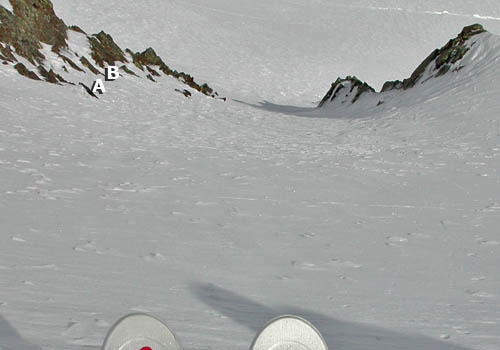Selective Stopping Spots
One of the basics of avalanche avoidance and good backcountry travel protocol is to always stop below your partner(s), not above them. The reason for this is two-fold; one is that you might blow your last turn and take out your partners from above, and the other is that the weight of a stopping person may cause the slope to fracture, especially if it is already weighted by another person. If this happens, it often breaks right at the top person’s skis and then takes the lower person for a ride. I had this happen once and it was almost a slow-motion comedy. I had stopped, then my partner skied up behind me, came to a stop, the slope fractured at this edges and I started to get swept away, but not before I said “Thanks.” to which he said “Sorry.” It had a happy ending as I was able to grab onto a tree, but ever since then, I go out of my way to stop in places where my partners will have a hard time stopping above me.
It is a subtle difference (and kind of a bad photo to illustrate the point), but stopping position “A” is much better for the first person than stopping point “B” although both are about the same as far as being protected from an avalanche coming down from above. Position “A” is tucked right up underneath a rock, which doesn’t leave the second skier any other chance BUT to stop below you.
________________________________
Help support StraightChuter.com and find your partner quickly if you accidentally send them for a ride, with a Pieps DSP Smart Transmitter from Backcountry.com. Click on the photo below…

Category: 07 Avalanche Avoidance










Excellent post; as more and more people step out of bounds at resorts, little things like this frequently get forgotten. It’s tempting to think of the slack as a secret powder stash instead of being uncontrolled. Do the little things right every time, and you will be about 1000x safer than if you don’t!
Useful advice. Thanks. Not stopping above your partner is an age-old commandment. The idea of attempting to guarantee that your partner can’t inadvertently hurt the team is an excellent one, and one I hadn’t heard before.
When I first started patrolling and doing avy work the old timers hammered into me three rules: One at a time, Always keep your partner in sight, and Never stop above your partner. Two others I’ve added to the mantra over the years are: Always have an escape plan, and move from safe zone to safe zone.
I’m glad these points are being brought up, hopefully the slackcountry crowd can hear them.
Andrew … you are on a roll here, great info! All of the guides that I’ve had in La Grave required us to always stop above them everywhere we went. Now that you’ve covered where to stop, how about a tip on which direction to face. I’ve always been told to face towards the slope and not towards the wall/rocks.
Hi Mark – I’ve never thought about which way to face when you stop, but in general, I’d say face the direction where you feel you can move to a safe spot if an avalanche comes down. In some cases this might be further into the wall, in others you might need to move outward.
As far as which direction to face, the IFGMA guides including Pelle, all explained that you want to face in towards the slope, with your tails up against the wall/rock. IMO it was better to have the client already in the best position if something happened, in lieu of hoping that they would respond appropriately, if they could even reposond.
The guides reasoning was that it placed you in a better stance to respond. If the snow grabbed your tails it would throw you backwards down the slope. Verses if the snow grabbed your tips and pointed you down the slope; you could fall on your back, you would be feet first, and in a better position to rollover and arrest (with your whippet).
Great article, love seeing people point out the little things you can do to increase the safety margin in the hills